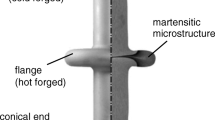The long cooling time during heat treatment of a large forging due to mass effect leads to the creep deformation at not only high temperature but also transformation temperature ranges. Therefore, both the transformation plasticity and the creep together with the phase transformation significantly affect the stress distribution of the forging after the heat treatment. In this study, a FEM model considering both the transformation plasticity and creep was developed. Proposed model was integrated into commercial FEM codes ANSYS via user subroutines. The material properties of the transformation plasticity and creep were also measured experimentally. For experimental verification, the residual stress measurements of the large forged shaft are compared with those of the simulations. The simulations show that the residual stresses were mainly caused by the phase transformation stress. In particular, it is found that both the transformation plastic strain and the creep strain play important roles in simulating the residual stress during heat treatment of a large forged shaft.
















Similar content being viewed by others
References
T. Inoue and Z. Wang, “Coupling between stress-temperature-metallic structures during processes involving phase-transformations,” Mater. Sci. Technol., 1, No. 10, 845–850 (1985).
S. Denis, S. Sjöström, and A. Simon, “Coupled temperature, stress, phase- transformation calculation model numerical illustration of the internal-stresses evolution during cooling of a eutectoid carbon-steel cylinder,” Metall. Trans. A, 18, No. 7, 1203–1212 (1987).
M. Fukumoto, M. Yoshizaki, H. Imataka, et al., “Three-dimensional FEM analysis of helical gear subjected to the carburized quenching process,” J. Soc. Mater. Sci., 50, No. 6, 598–605 (2001).
R. Pietzsch, M. Brzoza, Y. Kaymak, et al., “Simulation of the distortion of long steel profiles during cooling,” J. Appl. Mech., 74, No. 3, 427–437 (2007).
C. Simsir and C. H. Gur, “3D FEM simulation of steel quenching and investigation of the effect of asymmetric geometry on residual stress distribution,” J. Mater. Process. Tech., 207, 211–221 (2008).
C. C. Liu, X. J. Xu, and Z. Liu, “A FEM modeling of quenching and tempering and its application in industrial engineering,” Finite Elem. Anal. Des., 39, No. 11, 1053–1070 (2003).
M. Fukuya, T. Terasaki, H. Imamura, and A. Fujita, “Relation between transient stress and quenching cracks in cylinders generated by quenching,” J. Jpn Soc. Naval Arch. Ocean Eng., 6, 119–129 (2007).
M. Taschauer, G. Panzl, V. Wieser, et al., “New perspectives on heat treatment of large forgings,” in: Proc. of the 19th International Forgemaster Conference, Japan (2014), pp. 1–10.
S. Denis, E. Gautier, A. Simon, and G. Beck, “Stress phase-transformation interactions-basic principles, modeling, and calculation of internal-stresses,” Mater. Sci. Technol., 1, No. 10, 805–814 (1985).
Y. Kawaragi, M. Fukumoto, and K. Okamura, “Effect of implicit integration scheme in residual stress analysis of quenching considering transformation plasticity and kinematic hardening,” J. Soc. Mater. Sci., 64, No. 4, 258–265 (2015).
M. Umemoto, K. Horiuchi, and I. Tamura, “Transformation kinetics of bainite during isothermal holding and continuous cooling,” Tetsu-to-Hagane, 68, No. 3, 461–470 (1982).
G. W. Greenwood and R. H. Johnson, “The deformation of metals under small stresses during phase transformations,” Proc. Roy. Soc. A, 283, 403–422 (1965).
Data Sheets on the Elevated-Temperature Properties of 18Cr-8Ni Stainless Steel for Boiler and Heat Exchanger Seamless Tubes (SUS 304H TB), NRIM Creep Data Sheet, No. 4B (1986).
S. Denis, E. Gautier, S. Sjöström and A. Simon, “Influence of stresses on the kinetics of pearlitic transformation during continuous cooling,” Acta Metall., 35, No. 7, 1621–1632 (1987).
C. C. Liu, K. F. Yao, and Z. Liu, “Quantitative research on effects of stresses and strains on bainitic transformation kinetics and transformation plasticity,” Mater. Sci. Technol., 16, No. 6, 643–647 (2000).
T. Y. Hsu, “Additivity hypothesis and effects of stress on phase transformations in steel,” Curr. Opinion in Solid State and Mater. Sci., 9, No. 6, 256–268 (2005).
Author information
Authors and Affiliations
Corresponding author
Additional information
Translated from Problemy Prochnosti, No. 2, pp. 36 – 48, March – April, 2017.
Rights and permissions
About this article
Cite this article
Yanagisawa, Y., Kishi, Y. & Sasaki, K. Analysis of Residual Stresses During Heat Treatment of Large Forged Shafts Considering Transformation Plasticity and Creep Deformation. Strength Mater 49, 239–249 (2017). https://doi.org/10.1007/s11223-017-9863-7
Received:
Published:
Issue Date:
DOI: https://doi.org/10.1007/s11223-017-9863-7




